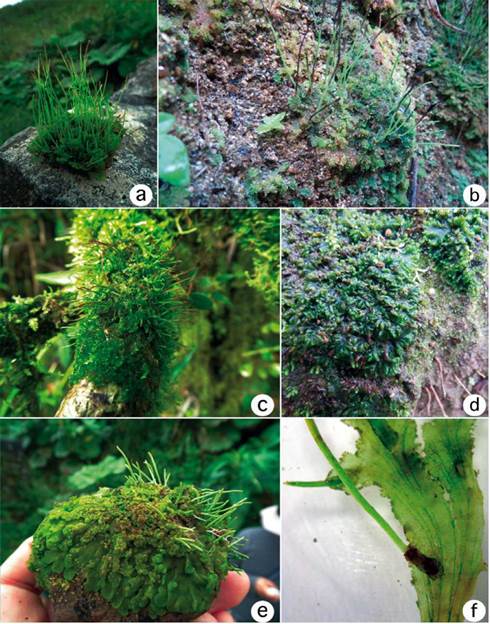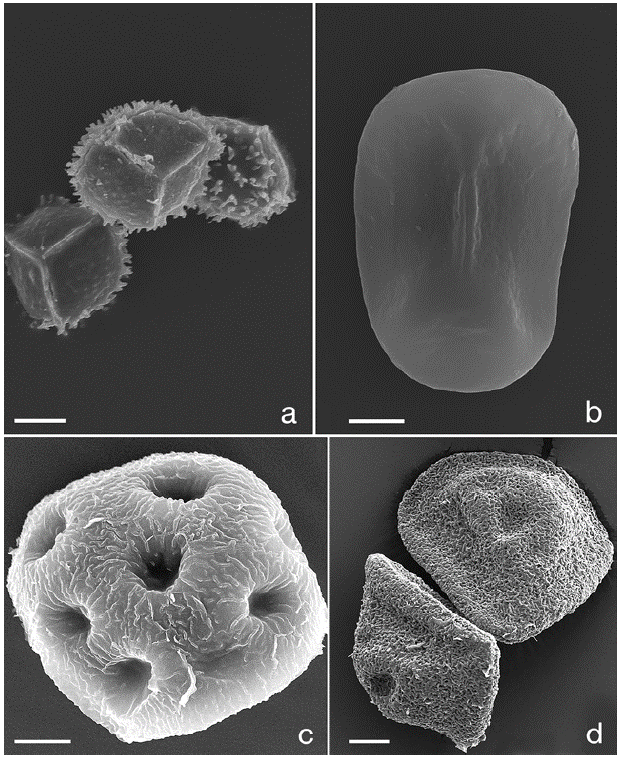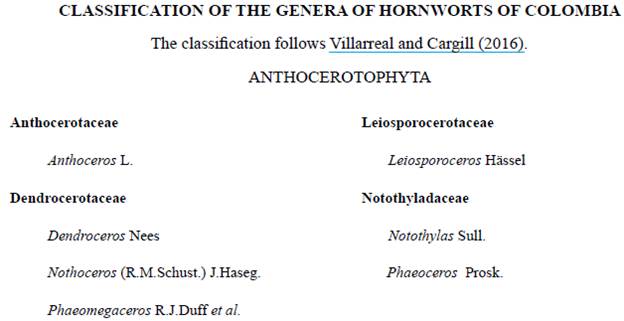INTRODUCCIÓN
Hornworts (Anthocerotophyta) are a small division of bryophytes containing about 192 accepted species worldwide (excluding 28 doubtful species), in five families and 12 genera (Villarreal and Cargill 2016). They are commonly found on soil in rather open places, but also on rotten logs, rock, bark or on living leaves. Hornworts were in the past often classified with the liverworts because of their superficial resemblance to thalloid liverworts but modern molecular-phylogenetic studies set hornworts apart, either as a lineage sister to the land plants or the vascular plants, or as a separate lineage within a monophyletic bryophyte clade (Morris et al. 2018, Puttick et al. 2018). Characters separating hornworts from other bryophytes include, among others: 1) thallus solid or with mucilage cavities, Nostoc colonies usually present in the thallus and visible as black dots, rarely as blue lines (in Leiosporoceros); chloroplasts large, 1-2(-4) per cell, frequently with a pyrenoid; 2) gametangia immersed in the thallus, originating from an inner thallus cell; 3) sporophyte narrowly cylindrical, without seta; 4) sporophyte growth by means of a basal meristem; 5) spore maturation asynchronous; and 6) capsule dehiscence gradual, from the apex slowly downwards, by means of 2(-4) valves, rarely by an operculum.
The elaters of hornworts are morphologically more diverse than those of liverworts and can be rounded or elongate, sometimes branched, unicellular or multicellular, with irregularly thickened walls or with a discrete spiral band. The multicellular elaters, found in the genera Anthoceros and Phaeoceros, are sometimes called pseudo-elaters. In this treatment the single term elater is used for all hornworts, following the "Guide to the bryophytes of tropical America" (Gradstein et al. 2001).
The spores of hornworts are usually richly ornamented, especially the outer spore surface (= distal surface), and are important for identification. A trilete, Y-shaped mark, indicating the position of the immature spores in the tetrad, is usually seen on the inner spore surface (= proximal surface). In the genus Leiosporoceros a trilete mark is lacking; instead a monolete tetrad mark is seen in this genus.
Hornwort diversity of Colombia has been documented in three successive catalogues (Gradstein and Hekking 1979, Uribe-M. and Gradstein 1998, Gradstein and Uribe-M. 2016). The most recent catalogue enumerated thirteen species, in four families and six genera (Gradstein and Uribe-M. 2016). Since the appearance of this list, two species of hornworts and one genus, Notothylas, have been added to the flora of Colombia (Gradstein et al. 2016), resulting in fifteen species and seven genera in Colombia. Colombia has as many hornwort species as Ecuador (León-Yánez et al. 2006 with updates); these two countries are the most diverse ones for hornworts in tropical America followed by Brazil with eleven species (Costa and Peralta 2015). One species, Nothoceros renzagliensis Villarreal et al., is thus far only known from Colombia (Villarreal et al. 2012).
In spite of the availability of several annotated species lists, hornworts have been very little studied in Colombia and floristic knowledge remains very poor. Numerous collections are housed in the National Herbarium of Colombia (COL) but many of them are without identification due to the lack of keys. The lack of a means of identification has prompted the author to prepare a key to the genera and species of hornworts of Colombia, in the framework of the "Flora of the Liverworts and Hornworts of Colombia and Ecuador" (Gradstein submitted). It is hoped that the present publication may stimulate the study of hornworts in Colombia. Three hornwort species known from Ecuador but not yet from Colombia, Dendroceros crispatus (Hook.) Nees, Phaeomegaceros squamuligerus (Spruce) J.C.Villarreal, and Phaeoceros tenuis (Spruce) Hässel, are also included in the key.
KEYS
Note: for details on species distribution in Colombia (biogeographical region, elevation, department) see http://catalogoplantasdecolombia.unal.edu.co/en/. Supporting figures are provided along with the key (Figs. 1, 2).

Figure 1 Hornworts of Colombia. a. Anthoceros lamellatus; b. Anthoceros tuberculatum, c. Dendroceros crispus; d. Notothylas orbicularis; e. Leiosporoceros dussii, showing androecia and sporophytes; f. Leiosporoceros dussii, showing linearly arranged colonies of cyanobacteria inside the thallus (= blue lines). Photographs by Enrique Hernandez (a, c, e), Jeffrey G. Duckett (b, d) and Juan Carlos Villarreal (f).

Figure 2 Spores of hornworts of Colombia. a. Anthoceros lamellatus, smooth inner spore surface with trilete tetrad mark (centre, left), spinose outer spore surface (right); b. Leiosporoceros dussii, smooth inner spore surface with monolete tetrad mark; c. Phaeomegaceros fimbriatus, outer spore surface; d. Phaeomegaceros squamuligerus, outer spore surface. Scale bars: a = 16 μm; b = 4 μm; c and d = 10 μm. Photographs by Juan Carlos Villarreal (a-c) and Frank Müller (d).
1. Thallus usually light green, whole thallus strongly crisped. Thallus differentiated into a midrib and unistratose wings. On branches, twigs or living leaves in humid montane forest areas........Dendroceros
1'. Thallus light green to dark green, whole thallus not strongly crisped. Thallus thickened to near the margins, not differentiated into midrib and unistratose wings. On soil, rock, rotten wood or trunk bases .......................................... 2
2. Thallus deep green to blackish-green, elongate, not forming rosettes, margins finely ruffled and ± colorless or subentire and green. Spores green, unicellular or multicellular. Elaters 1-celled, with spiral band. Sporophytes often very long, usually more than (4-)5 cm long. On rotten wood, trunk bases or rock in humid montane forests.......Nothoceros
2'. Thallus light green to deep green, usually forming rosettes, margins plane to crispate, green, not finely ruffled. Spores yellow, brown or black, unicellular. Elaters (1-)2-4-celled, without spiral band. Sporophytes shorter. On shaded soil or rock, often on road banks, not inside forests ....................................... 3
3. Thallus with internal cavities. Dorsal thallus surface reticulate due to cavities inside the thallus. Spores brown or black
............................................ Anthoceros
3'. Thallus solid, without cavities. Dorsal thallus surface not reticulate. Spores yellow to brownish .............................. 4
4. Thallus margins entire, dorsal thallus surface finely roughened by projecting epidermis cells. Thallus when fresh with long blue lines (= linearly arranged colonies of cyanobacteria inside the thallus) (Fig. 1f). Spores ovoid-oblong, yellow, surface smooth, without trilete mark (Fig. 2b) .............. Leiosporoceros
4'. Thallus margins entire or dissected, dorsal thallus surface not roughened by projecting epidermis cells. Thallus when fresh without blue lines, but frequently with black dots (= colonies of cyanobacteria). Spores rounded-tetrahedral, yellow or brown, surface ornamented, with trilete mark (Fig. 2a)
............................................................. 5
5. Sporophytes lying nearly horizontally on the thallus, ellipsoid, less than 5 mm long (Fig. 1d). Mainly lowlands ...........
............................................. Notothylas
5'. Sporophytes erect, more than 5 mm long, narrowly cylindrical (Fig. 1a). Montane, up to the páramo ................. 6
6. Outer spore surface vermiculate and with one or more rounded depressions
(Figs. 2c-d) ................................
Phaeomegaceros
6'. Outer spore surface with spines or papillae, not vermiculate, without rounded depressions ........... Phaeoceros
1. Anthoceros L. Figs. 1a-b, 2a
Aspiromitus Steph.
FURTHER ILLUSTRATIONS : Hässel de Menendez (1990), Gradstein and Costa (2003).
A subcosmopolitan genus of about 40 species; four in Colombia. On moist soil and rock in somewhat shaded places along trails and roads, from sea level to about 3000 m. The principal characters of Anthoceros are: 1) thallus light green, with internal cavities, margins dissected, dorsal surface usually reticulate due to the presence of inner cavities, smooth or with lamellae; 2) spores dark brown to almost black; 3) elaters 2-4-celled, without spiral band. Based on current knowledge, the neotropical species of Anthoceros can only be identified based on spore characters.
1. Inner spore surface smooth.....................
...........A. lamellatus Steph. (Figs. 1a, 2a)
1'. Inner spore surface rough, with blunt papillae or tubercles ............................ 2
2. Trilete mark of spores distinct. Outer spore surface densely covered by sharp spines, ornamentation of outer spore surface clearly different from ornamention of inner surface .............. 3
2'. Trilete mark reduced, indistinct. Outer spore surface densely covered by blunt papillae, ornamentation of outer andinner spore surface similar ....................
............................A. granulatus Gottsche
3. Spores small, 30-35 Lim in diameter. Inner spore surface with a large tubercle (much larger than the other ones) in the center of each of the three facets (= triangular spore surface areas bordered by the trilete mark) of the inner surface .........A. tuberculatus M.Howe (Fig. 1b)
3'. Spores larger, 40-60 Lm in diameter.
Large tubercle lacking ...........................
........................................A. punctatus L.
2. Dendroceros NeesFig. 1c
FURTHER ILLUSTRATIONS: Gradstein et al. (2001).
A pantropical genus of about 30 species; one in Colombia. On twigs, branches and living leaves in humid montane forest areas, up to 2500 m.The principal characters of Dendroceros are: 1) thallus differentiated into midrib and unicellular wings, the wings strongly undulate-crispate (neotropical plants), epidermis cells with trigones, midrib solid in neotropical plants; 2) capsule wall without stomata; 3) spores green, multicellular; 4) elaters long and narrow, with a spiral band.
1. Thallus wings with numerous large, colorless, irregularly arranged perforations (holes). Capsule epidermis cells with nodulose thickenings. Known from Ecuador, to be expected in Colombia................................
...........................D. crispatus (Hook.) Nees
1'. Thallus wings without large, irregularly arranged perforations (but with small, regularly arranged perforation in the cell angles). Capsule epidermis cells without nodulose thickenings ..........................
...............D. crispus (Sw.) Nees (Fig. 1c)
3. Leiosporoceros HässelFigs. 1e-f, 2b
FURTHER ILLUSTRATIONS: Villareal and Renzaglia (2006a).
A neotropical genus containing only one species, Leiosporoceros dussii (Steph.) Hässel. (Figs. 1e-f, 2b). On exposed, moist soil and rock in montane rainforest areas, particularly on road banks and along rivers, between 1800-3000 m. The principal characters of Leiosporoceros dussii are: 1) thallus rather fleshy, solid, margins entire, dorsal surface finely roughened by projecting epidermis cells; 2) Nostoc colonies linearly arranged inside the thallus; 3) spores pale yellow, ovoid-oblong, small, ca. 20 Lm long, surface smooth, without trilete mark (with monolete mark); 4) elaters long and narrow, 1-celled, walls thick, without spiral band.
4. Nothoceros (R.M.Schust.) J.Haseg.
ILLUSTRATIONS: Gradstein et al. (2001 as Megaceros), Villareal et al. (2010, 2012).
A widespread, tropical and southern-temperate genus of about 10 species; three in Colombia. On wet rock, rotten wood or trunk bases in montane forests, between 500-3750 m. Nothoceros was recently split from Megaceros on molecular grounds (Villarreal et al. 2010, 2012, Villarreal and Renner 2014) and is characterized by: 1) thallus solid (without cavities), green to dark green, pinnate or irregularly branched, usually without a midrib, margins crispate-undulate or finely ruffled and ± colorless; 2) thallus cells with 1-3 chloroplasts; 3) sporophytes erect and often very long (over 5 cm long), walls without stomata; 4) spores green, unicellular or multicellular; 5) elaters long and narrow (to 450 Lm long), with a spiral band.
1. Plants robust, more than 2 cm long, dark-green. Thallus margins undulate-crispate. Mature sporophytes more than 4 cm long. Epidermis cells with (1-)2-3 chloroplasts, the chloroplasts with or without pyrenoids. On wet rock, logs or soil. Monoicous, frequently with sporophytes ................... N. vincentianus (Lehm. & Lindenb.) J.C.Villarreal
1'. Plants smaller, less than 2 cm long. Thallus margins strongly ruffled, sometimes partly entire. Mature sporophytes smaller, less than 3 cm long. Epidermis cells with 1(-2) chloroplasts, without pyrenoids. On bark, growing over bryophytes. Monoicous or dioicous, often sterile .......................................... 2
2. Thallus dark-green, strongly elongate, ca. 3-8x longer than wide, pinnately branched. Epidermis cells with 1 chloroplast. Thallus margins strongly ruffled throughout. Dioicous. Spores unicellular.....................N. aenigmaticus (R.M.Schust.) J.C.Villarreal & K.D.McFarland
2'. Thallus light-green, as wide as long or slightly elongate, 1-2x longer than wide, irregularly branched. Epidermis cells with 1-2 chloroplasts. Thallus margins partly entire. Monoicous.
Spores multicellular ............................
........N. renzagliensis J.C.Villarreal et al.
5. Notothylas Sull.Fig. 1d
FURTHER ILLUSTRATIONS: Gradstein and Costa (2003; but see Note below).
A pantropical and northern-temperate genus of 20 species; three in Colombia. On moist soil in open, disturbed places, on trails and in gardens at low elevations, from sea level to 750 m. The principal characters of Notothylas are: 1) thalli usually forming small rosettes, solid, margins entire to lobulate but not ruffled; 2) mature sporophytes very short, to 5 mm long, ellipsoid, lying almost horizontally on the thallus (Fig. 1d) and largely enclosed in the involucre, walls without stomata, columella ± absent; 3) spores yellow or dark brown; 4) elaters rounded, walls irregularly thickened, without spiral band.
Note: in the key to species of Notothylas from Brazil (Gradstein and Costa 2003) the characters of N. orbicularis are interchanged with those of N. vitalii.
1. Thallus rosettes rather large, often more than 2 cm in diameter. Mature spores dark brown. Elaters present (rounded) .............N. breutelii (Gottsche) Gottsche
1'. Thallus rosettes smaller, 0.5-1 cm in diameter. Mature spores yellow. Elaters present or absent..................................2
2. Elaters present, rounded. Capsule opening by 2-4 longitudinal valves ........
N. orbicularis (Schwein.) Sull. (Fig. 1d)
2'. Elaters absent. Capsule opening by an operculum.........N. vitalii Udar & Singh
6. Phaeoceros Prosk.
ILLUSTRATIONS: Hässel de Menendez (1989), Gradstein and Costa (2003).
A subcosmopolitan genus of about 30 species; two in Colombia. On moist soil and rock at roadsides, along rivers, water courses and near springs, between 650-3000 m. The principal characters of Phaeoceros are: 1) thallus deep green, rather fleshy, solid (without cavities), margins entire or somewhat dissected, dorsal surface smooth, not reticulate; 2) spores yellow; 3) elaters (1-)2-4-celled, without spiral band.
Based on current knowledge, the neotropical species of Phaeoceros can only be identified based on spore characters.
1. Outer spore surface with blunt papillae. Known from Ecuador, to be expected in Colombia.......P. tenuis (Spruce) Hässel
1'. Outer spore surface with sharp spines . 2
2. Inner spore surface with a group of small papillae in each of the three facets (= triangular surface areas bordered by the trilete mark) of the inner surface. Autoicous ...................P. carolinianus (Michx.) Prosk.
2'. Inner spore surface smooth. Dioicous ...............................P. laevis (L.) Prosk.
7. Phaeomegaceros RJ.Duff et al. Figs. 2c-d
FURTHER ILLUSTRATIONS: Villarreal and Renzaglia (2006b).
A genus of seven species; one in Colombia. On moist soil on roadsides and along rivulets in open montane environments and páramo, between (600-)2000-4000 m. The principal characters of Phaeomegaceros are: 1) thallus as in Phaeoceros but chloroplasts without pyrenoids; 2) spores yellow, spore surface vermiculate, with one or more depressions on the outer surface; 3) elaters (1-)2-4-celled, without spiral band.
1. Dorsal thallus surface smooth or slightly roughened by projecting epidermal cells. Outer spore surface with seven rounded depressions: one central depression surrounded by a ring of six depressions
(Fig. 2c) ..................................................
P. fimbriatus (Gottsche) R.J. Duff et al. 1'. Dorsal thallus surface with triangular or lamellate outgrowths. Outer spore surface with one rounded depression, ring of six depressions lacking (Fig. 2d). Known from Ecuador, to be expected in Colombia ................................................
P. squamuligerus (Spruce) J.C.Villarreal
















